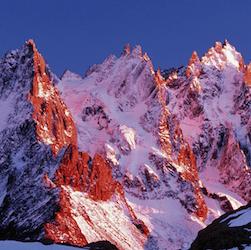
Before I left for Chamonix to go hiking in the French Alps, I borrowed Solo Faces by James Salter from the lending library at work. It felt almost like a sin to see a Salter novel with its tattered spine discarded amidst 50 Shades of Grey and a Madonna biography. My list of must-reads was long and only growing longer, but the ghostly mountain landscape of its cover caught my eye—a silhouetted man ascended a jagged peak. Fitting since I would be going to the French Alps the next day for a week of hiking. Also, it made me think of Matt. He wasn’t coming on this trip. We hadn’t even talked in years.
I didn’t grow up near the mountains. My family wasn’t the type to ski or climb or even hike. I was raised in the humid heat of rolling Alabama. I didn’t discover rock-climbing until I went to college in the Carolinas. It was there I started to take weekend trips with my boyfriend Matt to the Blue Ridge Mountains one state north. We’d camp amongst the Pisgah pines and under stormy Southern skies, then wake and make our way up multi-pitch routes on Laurel Knob, Looking Glass, and Rumbling Bald. We’d fasten ourselves to cliffs with small pieces of fabric called “daisy chains” long enough to eat lunch, our feet dangling likes branches in the wind. Matt taught me how to repel off exposed cliffs, to detect fingernail-sized holds in the sides of the smoothest rock, and how to tie a knot that held my body weight.
One summer, he took a job at a mountaineering shop in Jackson, Wyoming. We spent three months apart and at the end of August I flew out to visit him. It was the first time I’d seen snow, much less glaciers. Glaciers in the summer, my stomach clenched. Snow in July. The Tetons glimmered on the horizon shellacked in blue ice. We attached axes to our backpacks and started up the Middle Teton’s Southwest couloir. We were going for the summit. Matt demonstrated the quickest way to self-arrest on a snowfield and showed me how to dig one end of the axe into the ice to pivot and brake.
“It’ll keep you from sliding all the way back to Jackson,” he said with a smile.
Matt was living his alpine dream. Hours spent flipping pages of The Alpinist, Rock and Ice, and Climbing Magazine in the comfort of our below sea-level apartment in Charleston had materialized into a high-altitude summer. Lean and leggy athletes slept in cars filled with nothing but well-cared-for gear. Their blue- and red-flecked climbing rope was arranged on their back seats like altars. There was something religious about these men and woman and the stillness of their minds. Their eyes were as calm and sharp as sheets of ice. They moved with measured intention through town, assembling things for their next journey into the backcountry. They didn’t seem afraid of anything.
The people Matt shared an apartment with reveled in the mythology and folklore of the outdoors. They spoke of people who set up slack-lines hundreds of feet above canyons and walked across without harnesses. They had friends who ran for 48 uninterrupted hours on rocky trails through searing 100-degree heat without anything to drink. They showed YouTube videos of themselves strapped into kayaks, gliding down waterfalls so frothed with whitewater I couldn’t imagine how a single stick could survive the drop, much less a human in a small, plastic boat. It was as if they couldn’t feel life without touching death.
At night, I watched Matt’s new friends lightly clutch the necks of their bottles around campsite embers after a day in the high mountains. They might have been monks in another life, cloistered hermits, cloaked in orange robes, seeking god. It was a camaraderie of a divine and reckless brotherhood, and Matt was getting his initiation. I didn’t know if I should applaud or shudder. Their ability to suspend fear was stunning. They seemed immortal.
It wasn’t until I’d pitched my tent under the snowy gaze of Mont Blanc and began the first chapters of Solo Faces that I realized just how fitting it was to read this novel during my trip to the French, alpine town of Chamonix. The book, unknown to me, was set in the exact same location. The sun didn’t set until after ten, so light still spilled down from the sky as I lay in the grass after a long day of hiking in the Aiguilles Rouges. I rubbed the knots from my thighs and began to read about the mountains around me.
Solo Faces follows the life of a daredevil climber named Rand who left his life in California in pursuit of dangerous and glamorous climbs in the Alps outside of Chamonix. The French valley is home to Europe’s most legendary ski slopes, and the continent’s highest point—Mont Blanc. As Salter describes it:
Chamonix was at one time an unspoiled town…It lies in a deep V in the mountains, in the valley of the Arve, a river white with rock dust that rushes in a frenzy beside the streets. Overshadowing the town are the lower slopes of Mont Blanc with snouts of glaciers alongside…It is a block of mountain, formed by a vast cleaving before even the time of the dinosaurs and drowned in seas that covered Europe after they disappeared.
This area is credited as the birthplace of mountaineering. Bronze statues of famous climbers and their godly ascents are scattered through the city. It’s a nod to the impact climbing has had on the region. Rand, reckless adventurer and modern-monk, as he is described in Solo Faces, spends the novel pursuing foolhardy routes up the very mountains that flanked the valley I was exploring. If he were real, there’d have been a statue of him on the streets of Chamonix.
Salter renders the world of climbing with such exactness that it makes my forearms ache. Over the years, I’ve become less of a participant in climbing and more of a spectator. Maybe I’m not as brave as I hoped. But the stories, the myth making inherent in the communities who seek great heights and lonely places, still enchant me. Salter is able to capture climbing’s mystic in startlingly crisp sentences. He writes about the intersection of bravery, foolishness, and fear. Here is Rand facing a problem on the exposed cliff of a remote mountain:
They came to a wide slab, chillingly exposed. The holds were slight, hardly more than scribbled lines. There was no place to put a piton. As he went on, Rand could feel a premonition, a kind of despair becoming greater, flooding him. It is belief as much as anything that allows one to cling to a wall.
I read about Rand’s three-day, fictionalized climb up the side of the stormy, avalanche-prone face of the Dru. Then I hiked a glacier the next morning to see it in person. The rock face was just as imposing as Salter described it. Clouds shrouded the summit, and I hoped there were no climbers stranded on its treacherous routes. Salter does not ignore the mortal danger inherent in mountaineering. More than one of the experienced climbers in his novel loses the use of their limbs or even their very life from exquisite falls on famous mountains. Reading Solo Faces was like reading a guidebook to the place where I was, but also where I had been. Salter distills the essence of climbers, their egos and their minds, in such a precise way that I could not help but conjure the faces of people I once knew.
Matt and I broke up soon after college. I wanted to date women. Our paths diverged. I watched him, through social media and occasional Skype dates, devote his life even more to the mountains. Matt succumbed to his western, Teton-tinged wanderlust and moved back to Wyoming for a short time.
As the last man I truly loved, Matt’s become mythic to me; the time we spent together lives on in keepsakes I tout with me from city to different city—a bandana I wore in the mountains, an auburn bag we used to fill with soft white climbing chalk. Reading Solo Faces, I felt like I was peering into a life Matt and I once longed for, one I never entered completely. One he did, at least for a while.
When I see Salter’s characters shedding the trappings of ordinary life in order to find some holy order in remote places, like seekers have done for centuries, I see Matt’s face upturned to some peak, the tightness in his chest unable to loosen until he finally found his way. I see his feet, stuffed inside orange climbing shoes, steadily ascending the face of a route we’d never tried on a rock that seemed to be breathing, slowly, under my fingers. Whether Matt is still climbing today, that I can’t say. He’s still climbing in my memory, and maybe that’s enough.
This is the power in a well-written novel. It not only creates an entirely new literary world full of rich and realistic characters, but it transports me back to real places from my real life that I haven’t been in a long time. It reminds me why I loved those places and those people, but also it reminds me that they’ve stayed in my past.





